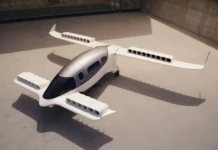Electric-powered airplanes may still be far from mainstream, but interest in this technology continues to grow. In late April, Airbus engineers successfully flew the E-Fan, a tandem two-seater with a pair of electric-powered ducted fans on the tail. The batteries, carried in the wings, provide 30 minutes of flight. Airbus officials said they hope to develop an electric-powered regional airliner within 20 years. Also in April, the annual CAFE Electric Aircraft Symposium was held in Santa Rosa, Calif., bringing together experts from around the world. Discussions included advances in lithium-battery capacity, hybrid powertrains for general aviation, quiet and efficient propellers, and new designs to simplify using computers in the cockpit.
Although the FAA continues to move at its normal glacial pace toward integrating unmanned aircraft systems into the National Airspace System, the UAS industry is blazing ahead. In May, an FAA official said it could take until 2020 to finalize rules for integration, but at the annual trade show for the Association for Unmanned Vehicle Systems International, held in Orlando, Fla., advocates were hopeful that some kind of rules could be worked out sooner. At the show, manufacturers showed drones capable of aerial photography, crop dusting, power line maintenance, and more–but the key to their success may be proving they can consistently sense and avoid other aircraft.
This quiet new diesel engine represents “a new paradigm in aviation propulsion,” according to test pilot Dick Rutan, who crewed the first flight on May 2. The aviation community will get a chance to judge that for themselves when a modified Cirrus SR22 using that engine flies into EAA AirVenture in late July. EPS said testing will continue, and they hope to show that the engine, which can be fueled with Jet-A, JP-8, or straight diesel, is just what the general-aviation industry needs. The fuel-efficient engine is easy to operate with a single power lever, the company says, and is built with rugged materials that will expand the time between overhauls to 3,000 hours. The company said it expects certification by 2016.
The light-jet segment has been slow to rebound from the recession, but Pilatus has improved the recovery rate with its new PC-24. The company took 84 orders at the European Business Aviation Convention and Exhibition in May, essentially selling out production through 2020. The 10-seat twin-engine jet will be certified to operate from gravel and grass runways, and will travel up to 1,950 nautical miles at speeds up to 400 knots. First flight is expected in early 2015, with deliveries to start two years later.
An FAA Airworthiness Directive affecting about 6,000 airplanes with cylinders from Superior Air Parts took effect in April, but in May, the FAA approved an alternative means of compliance (AMOC) that may relieve the time and expense involved for some owners. “Under the guidelines of this new Global AMOC, owners of aircraft who have over 12 years on their affected Millennium cylinders but have not yet reached TBO, will be able to alternately comply with the AD through ongoing inspections of their cylinders,” said Ken Chatten, general manager of Superior. The AMOC could extend the life of the cylinders by up to five years until the already established 17-year time-in-service limit, provided they pass all the inspections and checks.
Icon Aircraft announced it will open a factory in Vacaville, Calif…The FAA and GA advocacy groups joined to promote weather safety for GA pilots…AOPA launched its regional fly-ins and declared the concept a success…The National Park Service protected a plane-crash site in the Grand Canyon as an historic landmark…A former Blue Angels commander is under investigation for “encouraging an inappropriate work environment” while leading the squadron…Diamond Aircraft recalled about 100 of its furloughed workers, citing improved sales…SyberJet expanded its facilities in Utah, preparing for SJ30 deliveries…See breaking news in general aviation at www.avweb.com.




